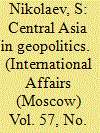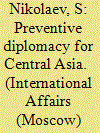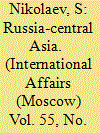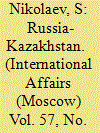|
|
|
Sort Order |
|
|
|
Items / Page
|
|
|
|
|
|
|
| Srl | Item |
| 1 |
ID:
104252


|
|
|
|
|
| Publication |
2011.
|
| Summary/Abstract |
CENTRAL ASIA has a rich history. At one time, it boasted the Great Silk Road, a major trade route between Europe and China. It was also an arena where Chinese, Mongolian, Persian, Turkish, and Arabian military commanders led their armies in brutal battles, prosperous towns were built and destroyed, and huge empires appeared and disappeared. So researchers have examined this region in the most diverse geographical configurations.
After the collapse of the Soviet Union, Central Asia became an independent geopolitical entity comprised of Kazakhstan, Kyrgyzstan, Tajikistan, Turkmenistan, and Uzbekistan. This concept became firmly ensconced in Russia (although during Soviet times, the region was defined as the Central Asian republics and Kazakhstan) and is adhered to by most experts in the West and the East. The OSCE also understands Central Asia as precisely these five former Soviet republics. There are also such projects as the "EU and Central Asia: Strategy for a New Partnership" and the "Central Asia plus Japan" which are aimed at developing relations with the region's states.
|
|
|
|
|
|
|
|
|
|
|
|
|
|
|
|
| 2 |
ID:
088146


|
|
|
|
|
| Publication |
2009.
|
| Summary/Abstract |
COUNTRIES IN CENTRAL ASIA are exposed to a number of conflict-provoking threats: terrorism and extremism, drug trafficking and organized crime. Turning to the UN for good services in this context looks logical since the UN has many tools to react to such threats and experience in settling the most diverse conflicts.
This led to the establishment in Ashgabat of the new international agency - the UN Regional Center for Preventive Diplomacy for Central Asia (UNRCCA).
As early as November 2004, Turkmenistan proposed the creation of UNRCCA. The initiative was backed by Kazakhstan. Next there followed a series of consultations between representatives of all five Central Asian states who gave this idea their unanimous approval and agreed to headquarter the Center in the capital of Turkmenistan.
On May 7, 2007, UN Secretary General Ban Kimoon informed the chairman of the UN Security Council Zalmay Khalilzad that, in line with the UN Global Counter-Terrorism Strategy and recommendations of the High-Level Panel on Threats, Challenges and Change pertaining to the need to boost the UN potential for the prevention of conflicts, he intended to establish UNRCCA in Ashgabat.
|
|
|
|
|
|
|
|
|
|
|
|
|
|
|
|
| 3 |
ID:
090456


|
|
|
| 4 |
ID:
102812


|
|
|
|
|
| Publication |
2011.
|
| Summary/Abstract |
TODAY IT IS COMMON for regions throughout the world, especially border regions, to make an increasing contribution to the development of interstate ties. Relations between Russia and Kazakhstan can serve as a model in this respect. The 7th Russia-Kazakhstan Interregional Cooperation Forum, held in Ust-Kamenogorsk (Kazakhstan) on 6-7 September 2010, is a good occasion for assessing the state and prospects of this cooperation format.
These (already traditional) forums have their own history. They originated as cross-border forums, and this was only natural because Russia and Kazakhstan share a border more than 7.5 thousand kilometers long. Twelve constituent entities of the Russian Federation (Altai Republic, Altai Krai, and the Astrakhan, Volgograd, Kurgan, Novosibirsk, Omsk, Orenburg, Samara, Saratov, Tyumen, and Chelyabinsk regions) border on seven regions of Kazakhstan (Aktobe, Atyrau, East Kazakhstan, West Kazakhstan, Kostanay, Pavlodar, and North Kazakhstan).
|
|
|
|
|
|
|
|
|
|
|
|
|
|
|
|
|
|
|
|
|